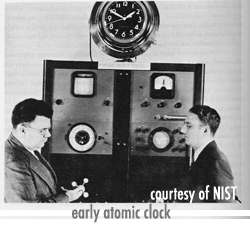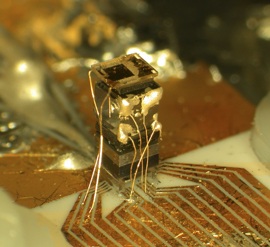In man’s quest to capture time, no innovation has come closer to measuring time with precision than the atomic clock. Using Cesium-133 atoms, scientists and engineers have implemented atomic clocks in a variety of experiments and systems. Since the 1960s, atomic clocks proved to be more precise than other timekeeping methods and being so, the second, the fundamental unit of time, was defined in terms of the atomic resonance of cesium-133. The fine-point accuracy of atomic clocks opened up the door for revolutionary technology such as the Global Positioning System, or GPS. Communication systems also rely heavily on atomic time in order to ensure data is transmitted and received at precisely the right timing.
Introduction
The atomic clock has revolutionized the 21st century Atlas (Fig. 1). What would happen if the Atlas of our time would suddenly shrug?
According to Klinkenborg, a writer for Discover magazine, “the Internet would dissolve into an array of freestanding, no-longer-networked computers. … Trade would abruptly cease on Wall Street, and money and shares would come to rest wherever they were.” Jo Ellen Barnett, author of Time’s Pendulum, notes that atomic clocks keep the “frequency standard without which our televisions, radios, computers and all our communications systems could not work.” It is no understatement to say, as Barnett pointed out, that “modern society is literally held together by electronic technology that routinely communicates by signals synchronized to billionths of a second” (169). While atomic clocks are not an essential element to society’s survival, this technology is expanding the limits of telecommunications.
Redefining the Second
Before integrating precise methods of timing into our technology, we first had to define the fundamental unit of time: the second. Initially, the second had been defined as 1/86,400 of a mean solar day, a value obtained by slicing the day into 24 hours, breaking each hour into 60 minutes, and dividing each minute into 60 seconds. With the advent of the atomic clock, a better method of defining the second came into play: instead of breaking up the solar day into smaller and smaller bits, a new “bottom-up definition” came into play where “the day had officially become 86,400 atomic seconds, and the atomic second the single fundamental unit of time” [1].
Equally interesting as to how the second is defined is the question of why the second had to be redefined. If we use the solar day to measure the second, we quickly discover by scientific experiments the inadequacy of using the earth as our timekeeper. The problem stems from the erroneous assumption that the earth consistently traces out the same path around the sun. Scientists have evidence that points to how the earth does not run like clockwork; it displays idiosyncrasies such as wobbling about its axis and, like its interstellar neighbors, is “gradually losing energy, slowing down, and spiraling toward the sun” [1]. The idea here is that the distance between the sun and earth is decreasing very slowly over time.
Understanding how the old definition of the second proved to be inadequate in carrying out accurate measurements gives us motivation to find a better mechanism to measure time. According to Thomas Udem of the Max Planck Institute for Quantum Optics in Garching, Germany, to better the accuracy of a clock one needs to “increase the rate at which it ‘ticks'” [2]. In other words, by decreasing the period of the clock, one automatically increases its accuracy. Consider the following: the purpose of a pendulum in a clock is to keep track of the seconds. Imagine taking that pendulum and swinging it faster and faster from side to side, thus decreasing the period, or the amount of time it takes for the pendulum to swing from one side to the other. Now make that pendulum ‘tick’ more than a billion times from side to side. If you were to compare this altered pendulum rate with that of a regular pendulum clock, you would be able to define a second in the regular pendulum clock by the number of times the former pendulum swung side to side within that second. This model is very similar to how vibrating atoms were used to define the length of a second. In the 1967 General Conference of Weights and Measures, this very method was used to define the length of the second as the “duration of 9,192,631,770 cycles of microwave light absorbed or emitted by the hyperfine transition of Cesium-133 atoms in their ground state undisturbed by external fields” [3].
Nature’s Tiny Pendulums
Before we understand specifically how we can harness the vibrations of a Cesium atom to accurately define the length of a second, we must take a look into the nature of atoms. What makes atomic clocks so special is how the atom can resonate at the exact same frequency whether it is here in the US or halfway around the world or in outer space. Identical atoms will emit and absorb the same frequency that changes their state; they share the same properties. Try comparing two mechanical clocks or two quartz clocks in different locations and you won’t get that kind of precision. The beauty of atomic clocks resides in their ability to act as near ideal pendulums. No friction, no aging, no distortion, and no running down – the atom proves to be the best known timekeeper.
Although it is the best known timekeeper, it is not a perfect timekeeper. An atomic clock’s precision can be tampered with if one allows external magnetic fields or electromagnetic radiation to interfere with the atoms. Even atoms bumping into each other contributes to a slight decrease in the accuracy of the clock. To get a near ideal pendulum, you need to screen out as many external influences as possible.
Cesium – The Timekeeping Standard
Many atoms can be used to measure the second; however, some are better candidates than others. Commonly used in atomic clocks, cesium has kept its post as the standard for measuring the second for over 50 years (Fig. 1). In determining the best “working” candidate, cesium stood out for three reasons:
- It works well at low temperatures; it has the lowest melting point compared to other alkali metals.
- It has only one stable isotope. This means we don’t have to worry about separating different types of cesium or using a mixture of different types of cesium.
- It possesses the “highest ground state hyperfine transition frequency among the stable alkali atoms, which helps in obtaining a high line Q” [4]. Q is called the line quality factor and is a measure of the “quality of the atomic transition as a frequency reference” [4].
Mechanics of the Cesium Atomic Clock
In taking apart a cesium atomic clock, you will find a much more dynamic environment than you would in a mechanical clock. Our “pendulum” is the cesium-133 isotope, which contains 54 electrons encircling the nucleus. These 54 electrons occupy certain spherical and stretched balloon-like orbits around the nucleus. These electrons can move to different orbits at higher energy levels by absorbing external packet so energy. When an electron releases energy in the form of electromagnetic radiation, it “falls” down to an orbit with lower energy. The number of orbits that “jump” up or down depends on the amount of energy they absorb or release respectively.
For the cesium atom, one electron that is farthest removed from the nucleus occupies an orbit all to itself. In this orbit, the electron’s energy can have two different values determined by a property called the “spin” of the electron, or the magnetic moment, which can be compared to a bar magnet with north and south poles. According to the Science Museum located in London, the energy difference between these two states “corresponds to radio waves with a frequency of 9,192,631,770 Hz (cycles per second)”, which we’ll call the hyped frequency. This means that if you zap the atom with microwaves at the hyped frequency, the electron in the farthest orbit will automatically switch its state. This is called the hyperfine transition.
But how does one count the number of swings of this atomic pendulum? One sample of cesium is placed in an oven at 100˚ C. Parallel beams emerge from the oven and pass through two non-uniform magnets (see Fig. 2). These magnets throw away high-energy cesium atoms by deflecting them outward (as indicated by the red line). Only the low-energy atoms (the blue line) pass directly into the vacuum cavity where radio waves bombard the atoms. A quartz crystal oscillator, located below the cavity, will send waves with frequency close to the hyped frequency. Some atoms will be hit with exactly that frequency whereas others will not. Those that are hit with that frequency will have the electron transition its state and, upon exiting the cavity and passing through the non-uniform magnets, will be deflected. These deflected atoms will be measured by a detector, which feeds back the information to the control circuits. The detector “gives an output proportional to the number of cesium atoms striking it, and therefore peaks in output when the microwave frequency is exactly correct” [5]. This peak frequency is fed back to the quartz crystal oscillator and adjusts the microwave field to that exact measurement. Once the frequency is locked on, one can obtain a pulse per second by dividing that value by the hyped frequency. The cesium atom will continue to resonate at this frequency, maintaining an accurate and consistent time measurement.
Atomic Clocks in Technology
Accurate timekeepers will not budge a second in a million years. But why do we really care about being that precise?
One of the innovations made possible by the atomic clock is the Global Positioning System, or GPS. GPS owes its existence to the accuracy of atomic clocks. With GPS, civilians may utilize satellite technology to track the position and velocity of an object in all weather conditions, and “transfer precise time on a continuous basis anywhere on or near the earth” (Major 432). GPS is a satellite-based system that allows the user to pin-point with a radio receiver an object within 10 meters [6]. The satellites send timed radio pulses that track the location of the object, even if it is moving. Klinkenborg comments that “the precision of the coordinates your GPS receiver gives you – whether you’re canoeing the Boundary Waters or surveying a new interchange on I-70 – depends directly on the precision on the time signal the system uses.” It is no trivial matter that atomic clocks are engineered to be accurate to 15 and 18 decimal places.
Timing in Communications
Telecommunications systems rely heavily on atomic time. In order for the receiver to reconstruct a signal, the data must be streamed at precisely the right time down to the nanosecond. Many systems require synchronization of transmitters and receivers in a network, which also depends on accurate time measurements. Atomic clocks are vital in synchronizing a global network of clocks. Instead of having clocks around the world err by seconds, atomic clocks allow the possibility for global clocks to err by only nanoseconds.
Conclusion
It is poetic to believe that time is relative. We accept that the global system of maintaining time based on the earth’s orbit is flawed, mandating the occurrence of a leap year. Most of the technology available to us today could still operate efficiently without the atomic clock. However, the technology available to us would not have as far reaching, precision-based impact as it has with this advanced accuracy for maintaining a measurement of time.






